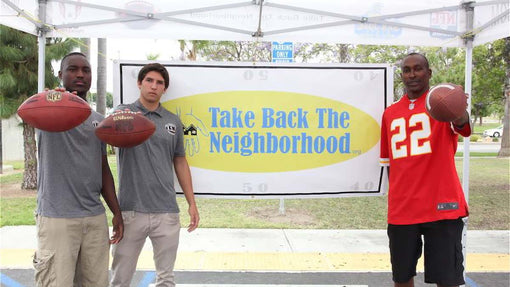How Our Morale Patch Adventure Began
Launching CALI Strong at the heart of a military community, right on the 32nd Street Dry Side Navy Exchange in San Diego, Jen and I were inspired by the profound sense of purpose and connection. The military's core values—honor, unity, and resilience—naturally became the foundation of our brand. Our military ambassadors are from Seal Team 6, Army Delta Force, and the Marines and guide us in addressing the military community's needs.
Our journey into creating morale patch hats was inspired by the rich tradition of military patches worn by our military members. We sought to bring a unique twist to this tradition by blending it with modern style and versatility. Our line of interchangeable patches allows for a dynamic and personal expression, enabling one hat to complement multiple outfits and occasions. The concept, deeply rooted in military tradition, has resonated well, attracting a broad civilian audience that appreciates the novel blend of utility and style.
With over 200 unique designs and an expanding collection of patch hat styles, CALI Strong has redefined the concept of morale patches. Our dedication to innovation, fueled by the insights and stories of both our military and civilian fans, has positioned us as pioneers in the space. We're proud to have the military community as our foundation, guiding us forward and reminding us of the impact of community and resilience.
But what is a morale patch? How were they used? And why does the history of morale patches matter? Let's dive in to show why!
British Influence and the Origin of Morale Patches
The first record of morale patches dates back over a century, when British troops wore them to distinguish allies from enemies and identify their unit (Cox 13).

In the U.S., the Army was first to use them when the 81st Division Wildcats wore them in WWI to identify ally units (Gateway to the Army Association). They also wore them to increase the morale of troops and comrades and make troops feel part of an actual team.
After their debut in WW1, John Pershing, a senior U.S. Army officer and commander of the American Expeditionary Forces who went by the nickname Black Jack, saw how helpful they were in battle, and as a result, required all brigades in the Army to design and wear a unique, easy-to-read patch of their own.
Ever since, morale patches have been used in police and military units to reflect loyalty to their brigade and to make combat safer, as they make it easier to tell who is on your team. They surely save lives and are a huge part of military fandom and culture, and they come in many unique shapes and designs!
So, who created morale patches, and where did they come from? Simply put, the British are the founding fathers of the morale patch as their uniforms had them first, and quite some years before the U.S. Army.
World War 1 Morale Patch – 81st Division Wildcats

Pictured here with General John J. Pershing is the unique, distinctive, hand-embroidered morale patch used in WW1 by the 81st Infantry Division known as the Wildcats.
At the time, there was little variety or patches to take inspiration from, so this is a custom one tailor-made by hand. Still, soon after, units and troops of all divisions began to wear one under orders from Pershing, who saw how effective the patches were.
Morale Patches - Their Intent and Surprising Purpose
Morale patches were first worn by Brits, with history saying they date back to the start of the 20th century and likely before WW1. Known as Battle Patches, British troops wore morale patches to make friendly troops easier to spot and enemy brigades easier to identify. This said, being able to tell ally and enemy troops apart was not the only reason these patches were worn, as it is pretty evident that they had a deeper, more meaningful purpose, and one that has all to do with symbolism!
As the name implies, the one who chose the name Morale Patches did so to raise the morale of fellow troops, and it worked! Above all, they’re a visual testament and reflection of loyalty to a brigade many troops spent years fighting in; they were also a way for troops to share jokes and stories and a way for them to bond and feel part of a team and family, which helped boost morale in the field!
Seven Interesting Facts About Morale Patches
#1 Morale Patch Origins
Morale patches existed before the First World War and are well-rooted in police and military culture. This is little surprise, though, as they were made over a century ago by the British Army, who called them Battle Patches- a suitable name for a patch used in war to tell allies apart from enemies!
#2 First U.S.-Issued Blood Chit
The Blood Chit is the great-grandfather of today’s morale patch. It is a notice carried by military personnel intended to be used when the service member is stranded or in trouble. It typically contains a message in several languages indicating that the bearer is a military member from a friendly nation and requesting that anyone who finds them offer assistance. The message often promises a reward for the service member’s safe return (Glines). A blood chit was first issued under George Washington in 1793 to prevent the mistreatment of a French balloonist ascending from Philadelphia. Later, blood chits were often sewn into uniform interiors, and they remain widely used in the military today (van Harmelen)!
#3 First Insignia Patch in World War 1
During the First World War, the first morale patch was made and proudly worn by the 81st Division Wildcats. It was first advised to senior Army officials that each division should have a patch of its own. Once the Wildcats submitted their patch for review, it was quickly approved! Soon after, units and troops from all divisions started wearing morale patches per General Pershing's mandates.
#4 Morale Patch Trading – Trading Morale Patches is a Pastime Favorite
During the 1920s, morale patches gained popularity among service members and civilians alike, and it was not long until people began trading, collecting, and exchanging them. This trend continues today, with many buying morale patches as a hobby or investment, as some can be pretty rare and valuable, like most items with this historical significance.
#5 They were Called ‘Battle Patches’ Before the Vietnam War

The name Morale Patch arose from the Vietnam War when it was common for troops to have slang, sarcasm, or rude and insensitive statements on their patches. These patches let troops and brigades express what mattered to them, and they helped camaraderie and good spirits among divisions thrive!
#6 ‘Anytime Baby!’ – The Popular Morale Patch Inspired by U.S. Navy Pilots

Many morale patches are World-War-era-inspired but modern ones, like the popular 'Anytime Baby' patch inspired by an aerial incident in the Gulf of Sidra (where U.S. Navy pilots downed a pair of Su-22 planes from Libya in 1981), gained popularity thanks to people like Tom Cruise and his infamous ‘Anytime Baby’ quote in Top Gun that made this patch one of the most popular today!
#7 Morale Patches, For Superheroes?!

You read that right, as people may be after not only police and military patches but ones themed on their favorite superhero, too! This makes morale patch collecting fun as there are so many to choose from with styles, varieties, and designs for every superhero you can imagine.
If you can think of it, there is likely a patch for it! Indulge in the addictive and enjoyable world of collecting morale patches. If you are like most, you will enjoy the hobby and have an extensive collection in no time!
How the Name 'Morale Patch' Was Coined
The British called them Battle Patches, but the US Military, who began adding them to uniforms in WW1, coined the term Morale Patches during their battle against Vietnam, and the name has stuck ever since!
Given the nature of war and the violence and bloodshed it hosts, you can imagine how grim, tolling, and mentally taxing it was on soldiers. However, much good came from these patches, as they were helpful in battle and served as a way for soldiers to have some fun/entertainment among nonstop, day-and-night havoc.
After all, these patches were unique to each unit and often had slang, humor, symbols, or catchphrases unique to the brigade that wore them. As such, they helped to lighten the mood and raise the motivation of troops, as the insignia helped them feel a great sense of being part of a team and family.
Of course, not all troops were fans of the idea when morale patches first became a thing. They only gained real traction once American troops wore them in World War 1. At that point, many US troops and brigades began creating their own to reflect their insignia and the values that meant most to them.
Let's go back as far as written history takes us. The 81st Infantry Division holds the title of the first to wear them, and WW1 was no better time as political emotions and escalations were haywire at the time. These patches allowed brigades and governments to give names or meanings to missions/deployments.
At first, the only patches in the military were those that bared the troop's name; they were often on the shoulder and issued to those who spent thirty or more days in combat, but once morale patches hit the scene, patches became quite prevalent. Tons of troops across many brigades lavished them.
So, what is a morale patch? Well, it is a patch that lets troops feel a part of something much more significant and greater than themselves; it instills a sense of brotherhood and makes it easier for brigades to connect meaningfully in a powerful, family-like fashion – a sacred bond that can make life better in arduous wars!
Trading, Buying, and Collecting Morale Patches
From family to civilians and comrades to collectors and enthusiasts, the number of people who share a love, passion, and appreciation for morale patches is only growing! Today, morale patches are traded and bought more than ever before, and now is the best of times to join the fun and growing community!
No matter the style you pick or the brigade you represent, know you are taking a big part in military culture and customs! Support vets, represent your division, or show love for your favorite brigade or superhero, and consider buying morale patches for your outfit or collection; they’re a great way to express yourself!
About the Author: Jim Stroesser
Jim Stroesser has amassed 38 years of experience in global consumer branding across the sports, fashion, and entertainment industries. Starting his career as a tech rep, he ascended to CEO roles with some of the world's leading brands. As the Co-Founder and CEO of CALI Strong Inc., a direct-to-consumer sports brand based in San Diego, CA, Jim has led the company in producing premium apparel, footwear, equipment, and accessories.
His tenure as Owner/Partner at Converse is particularly noteworthy. Jim was pivotal in reviving the brand from bankruptcy in 2001, elevating its value from $120 million to $285 million, and playing a crucial role in its $305 million sale to Nike in 2003, marking one of the century's significant mergers and acquisitions.
Beyond Converse, Jim has held senior management positions at renowned companies such as Nike, Quiksilver, Oakley, LA Gear, Pony, and Adio. He is also actively involved in several boards of directors positions, including SDSI, led by Chairman Bill Walton, which focuses on mentoring companies and assisting in capital raising efforts.
Works Cited
Cox, Reginald. Military Badges of British Empire 1914. Naval & Military Press, 1999.
Gateway to the Army Association. “Wildcat Amphitheater.” Gateway to the Army, Gateway to the Army Association, https://www.gatewaytothearmy.org/centennial-park/wildcat-amphitheater. Accessed 26 January 2024.
Glines, Carroll V. “Blood Chit.” Air & Space Forces Magazine, Air & Space Forces Magazine, 1 Oct. 1998, https://www.airandspaceforces.com/article/1098chit/. Accessed 26 January 2024.
van Harmelen, Jonathan. “Ben Kuroki's blood chit | National Museum of American History.” National Museum of American History, National Museum of American History, 6 September 2015, https://americanhistory.si.edu/explore/stories/ben-kurokis-blood-chit. Accessed 26 January 2024.




